roof rack AUDI S3 2015 Owners Manual
[x] Cancel search | Manufacturer: AUDI, Model Year: 2015, Model line: S3, Model: AUDI S3 2015Pages: 310, PDF Size: 76.15 MB
Page 64 of 310
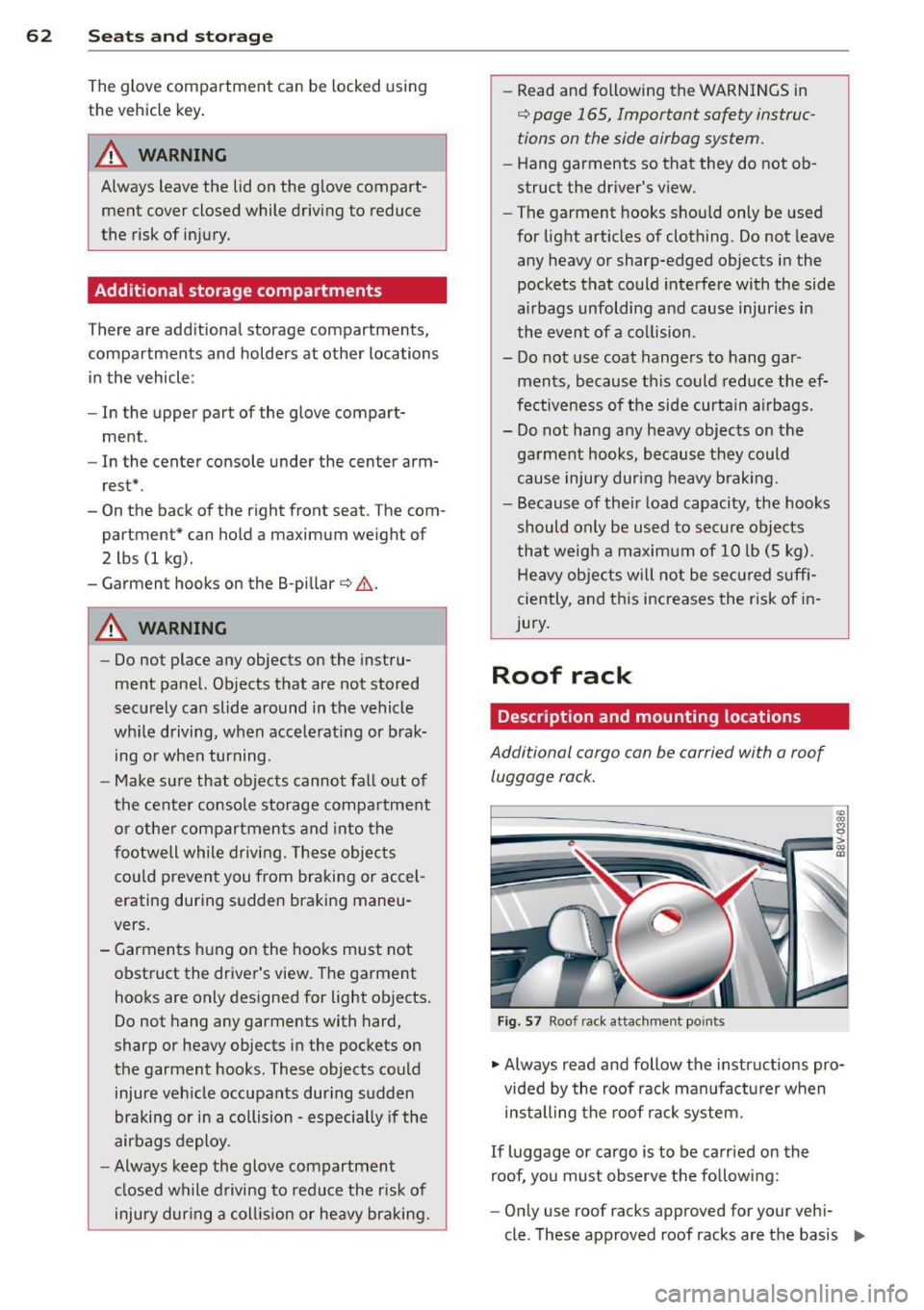
62 Seats and storage
The glove compartment can be locked using
the vehicle key.
.&_ WARNING
Always leave the lid on the glove compart ment cover closed while driving to reduce
the risk of injury.
Additional storage compartments
There are additional storage compartments,
compartments and holders at other locations
in the vehicle :
- In the upper part of the glove compart
ment .
- In the center console under the center arm
rest* .
- On the back of the right front seat. The com
partment* can hold a maximum weight of
2 lbs (1 kg).
- Garment hooks on the 8-pillar
c:> &, .
.&_ WARNING
-Do not place any objects on the instru
ment panel. Objects that are not stored
securely can slide around in the vehicle
while driving, when accelerating or brak ing or when turning.
- Make sure that objects cannot fall out of
the center console storage compartment
or other compartments and into the
footwell while driving. These objects
could prevent you from braking or accel
erating during sudden braking maneu
vers.
- Garments hung on the hooks must not obstruct the driver's view. The garment
hooks are only designed for light objects.
Do not hang any garments with hard,
sharp or heavy objects in the pockets on
the garment hooks. These objects could
injure vehicle occupants during sudden
braking or in a collision - especially if the
airbags deploy.
-Always keep the glove compartment
closed while driving to reduce the risk of
injury during a collision or heavy braking. -
Read and following the WARNINGS in
c:> page 165, Important safety instruc
tions on the side airbag system .
- Hang garments so that they do not ob
struct the driver's view.
- The garment hooks should only be used
for light articles of clothing. Do not leave
any heavy or sharp-edged objects in the
pockets that could interfere with the side
airbags unfolding and cause injuries in
the event of a collision.
- Do not use coat hangers to hang gar ments, because this could reduce the ef
fectiveness of the side curtain airbags .
- Do not hang any heavy objects on the garment hooks, because they could
cause injury during heavy braking.
- Because of their load capacity, the hooks
should only be used to secure objects
that weigh a maximum of 10 lb (5 kg).
Heavy objects will not be secured suffi
ciently, and this increases the risk of in
jury.
Roof rack
Description and mounting locations
Additional cargo can be carried with a roof
luggage rack.
Fig. 57 Roof rack attachment po ints
• Always read and follow the instructions pro
vided by the roof rack manufacturer when
installing the roof rack system.
If luggage or cargo is to be carried on the
roof, you must observe the following:
- Only use roof racks approved for your vehi-
cle. These approved roof racks are the basis ..,
Page 65 of 310
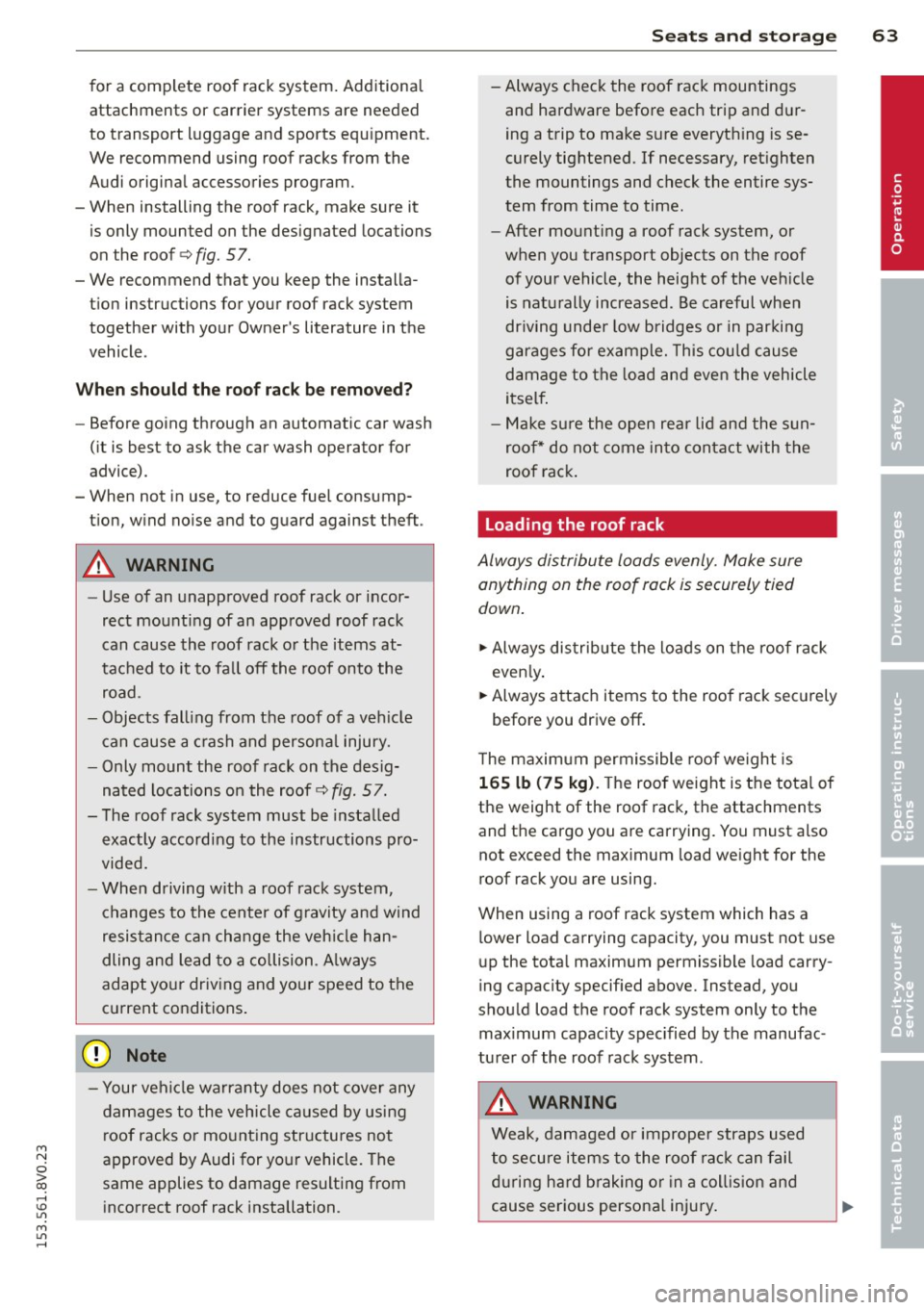
M N
0 > co ,...., \!) 1.1'1
M 1.1'1 ,....,
for a complete roof rack system. Additiona l
attachments or carrier systems are needed
to transport luggage and sports equipment.
We recommend using roof racks from the
Audi original accessories program.
- When installing the roof rack, make sure it
is only mounted on the designated locations
on the roof¢
fig. 57.
-We recommend that you keep the installa
tion instructions for your roof rack system
together with your Owner's literature in the
vehicle .
When should the roof rack be remo ved ?
-Before going through an automatic car wash
(it is best to ask the car wash operator for
advice).
- When not in use, to reduce fuel consump
t ion, w ind no ise and to guard against theft .
A WARNING
-Use of an unapproved roof rack or incor
rect mount ing of an approved roof rack
can cause the roof rack or the items at
tached to it to fa ll off the roof onto the
road.
- Objects fall ing from the roof of a veh icle
can cause a c rash and persona l injury.
- Only mount the roof rack on the desig
nated locations on the roof¢
fig. 57.
-The roof rack system must be installed
exactly according to the instructions pro
vided.
- When driving w ith a roof rack system,
changes to the center of g ravity and wind
resistance can change the veh icle han
dling and lead to a collision. A lways
adapt your driving and your speed to the
c u rrent conditions.
(D Note
- Your veh icle warranty does not cover any
damages to the veh icle caused by using
r oof racks or mo unting structures not
approved by Audi for your vehicle. The
same applies to damage resulting from i ncorrect roof rack installation.
S eat s an d sto rage 63
- Always check the roof rack mountings
and hardware before each trip and dur
ing a trip to make s ure everyth ing is se
curely tightened. If necessary, ret ighten
the mountings and check the entire sys
tem from time to time.
- After mount ing a roof rack system, or
when you transport objects on the roof
of your vehicle, the height of the veh icle
is naturally increased . Be careful when
dr iving unde r low bridges or in parki ng
garages for example. This cou ld cause
damage to the load and even the vehicle
itself .
- Make sure the open rear lid and the sun
roo f* do not come in to contact with the
roo f rac k.
Loading the roof rack
Always distribute loads evenly. Make sure
anything on the roof rack is securely tied
down .
.,. Always dis tribute the loads on the roof rack
even ly .
.,. Always attach items to the roof rack securely
before you drive off .
T he maxim um permissible roof we ight is
1 6 5 lb (75 kg ). The roof weight is the total of
the weight of the roof rack, the attachments
and the cargo you are carrying. You must a lso
not exceed the maximum load weight for the
roof rack you are using.
When using a roof rack system which has a
lower load carrying capacity, you must not use
up the tota l maximum permissible load carry
ing capacity specified above. Instead, you
should load the roof rack system only to the
max imum capacity specified by the manufac
ture r of the roof rack system .
A WARNING
Weak, damaged or imprope r straps used
to secure items to the roof rack can fail
during ha rd braking o r in a coll is ion and
cause ser ious persona l injury .
.
•
Page 66 of 310
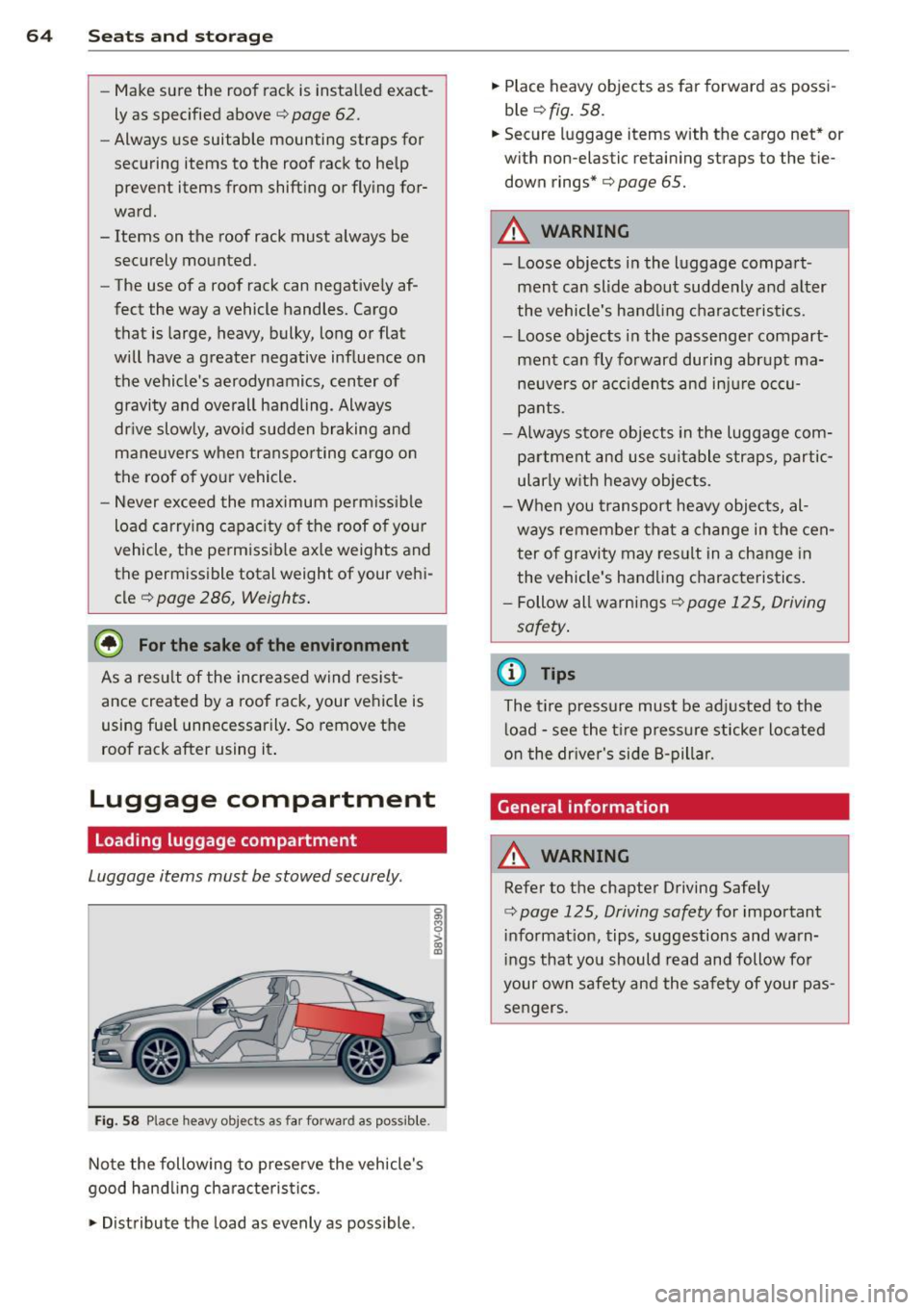
64 Seats and storage
-Make sure the roof rack is installed exact
ly as specified above
r::;, page 62.
- Always use suitable mounting straps for
securing items to the roof rack to help
prevent items from shifting or flying for
ward.
- Items on the roof rack must always be
securely mounted.
- The use of a roof rack can negatively af
fect the way a vehicle handles. Cargo
that is large, heavy, bulky, long or flat
will have a greater negative influence on
the vehicle's aerodynamics, center of gravity and overall handling. Always
drive slowly, avoid sudden braking and
maneuvers when transporting cargo on
the roof of your vehicle.
- Never exceed the maximum permissible
load carrying capacity of the roof of your
vehicle, the permissible axle weights and
the permissible total weight of your veh i
cle
r::;, page 286, Weights.
@ For the sake of the environment
As a result of the increased wind resist
ance created by a roof rack, your vehicle is
using fuel unnecessarily. So remove the
roof rack after using it .
Luggage compartment
Loading luggage compartment
Luggage items must be stowed securely .
Fig. 58 Place heavy objects as far forward as possible.
Note the following to preserve the vehicle's
good handling characteristics .
.,. Distribute the load as evenly as possible .
0
s
> "' m
.,. Place heavy objects as far forward as possi
ble
r::;, fig. 58.
.,. Secure luggage items with the cargo net* or
with non-elastic retaining straps to the tie
down rings*
r::;, page 65.
A WARNING
- Loose objects in the luggage compart
ment can slide about suddenly and alter
the vehicle's handling characteristics.
- Loose objects in the passenger compart
ment can fly forward during abrupt ma
neuvers or accidents and injure occu
pants.
- Always store objects in the luggage com
partment and use suitable straps, partic
ularly w ith heavy objects.
- When you transport heavy objects, al
ways remember that a change in the cen
ter of gravity may result in a change in
the vehicle's handling characteristics.
- Follow all warnings
¢page 125, Driving
safety.
'
(D Tips
The tire pressure must be adjusted to the
load -see the tire pressure sticker located
on the driver's side B-pillar.
General information
A WARNING ,-
Refer to the chapter Driving Safely
r::;, page 125, Driving safety for important
information , tips, suggestions and warn
ings that you should read and follow for
your own safety and the safety of your pas
sengers .
Page 157 of 310
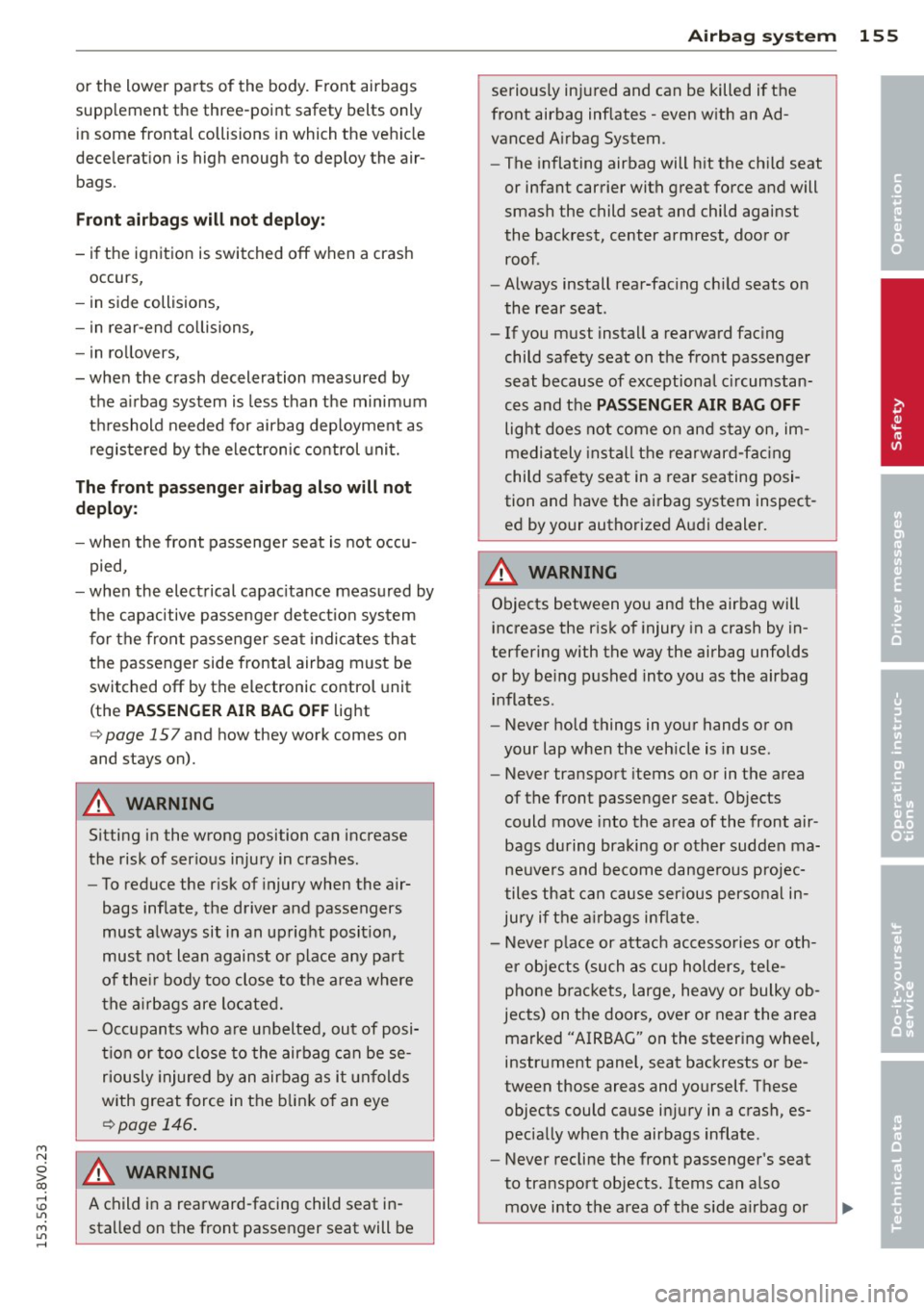
M N
0 > co ,...., \!) 1.1'1
M 1.1'1 ,....,
or the lower parts of the body. Front airbags
supp lement the three-point safety belts only
in some frontal collisions in which the vehicle
dece leration is high enough to deploy the air
bags.
F ront airbag s will no t deplo y:
- if the ignition is switched off when a crash
occurs,
- in side collisions,
- in rear-end collisions,
- in rollovers,
- when the crash deceleration measured by
the a irbag system is less than the m inimum
threshold needed for airbag deployment as
registered by the electronic control unit.
The f ront pas seng er airbag al so will n ot
deploy:
- when the front passenger seat is not occu
pied,
- when the electrical capac itance measured by
the capacitive passenger detect io n system
for the front passenger seat indicates that
the passenger side frontal airbag must be
switched off by the electronic control unit
(the
P AS SENGER A IR BA G OFF light
Q page 157 and how they work comes on
and stays on).
A WARNING
Sitting in the wrong position can increase
the risk of serious injury in crashes.
- To reduce the r isk of injury when the air
bags inflate, the driver and passengers
must always sit in an upright posit ion,
must not lean against or place any part
of the ir body too close to the area where
the a irbags are located.
- Occupants who a re unbelted, out of posi
t ion or too close to the airbag can be se
riously injured by an airbag as it unfolds
with great force in the blink of an eye
Qpage 146 .
A WARNING
A child in a rearward-facing child seat in
stalled on the front passenger seat will be
-
A irbag system 15 5
seriously injured and can be killed if the
front airbag inflates -even w ith an Ad
vanced A irbag System.
- The inflating airbag will hit the ch ild seat
or infant carrier with great force and will
smash the child seat and child against
the backrest, center armrest, door or roof.
- Always install rear-fac ing ch ild seats on
the rear seat.
- If you must install a rearward fac ing
child safety seat on the front passenger
seat because of exceptional c ircumstan
ces and the
PASSENGER AIR BAG OFF
light does not come on and s tay on, im
mediately install the rearward-fac ing
child safety seat in a rear seating posi
tion and have the airbag system inspect
ed by your authorized Audi dealer.
A WARNING
Objects between you and the airbag will increase the r isk of injury in a crash by in
terfering with the way the airbag unfolds
or by be ing pushed into you as the airbag
inflates.
- Never hold things in your hands or on
your lap when the veh icle is in use.
- Never transport items on or in the area
of the front passenger seat. Objects
could move into the area of the front air
bags during braking or other sudden ma
neuvers and become dangerous projec
tiles that can cause ser ious personal in
jury i f the a irbags inflate.
- Never p lace or a ttach accesso ries o r oth
er objects (such as cup holders, te le
phone brackets, large, heavy or bulky ob
jects) on the doors, over or near the area marked "AIRBAG" on the steering wheel,
instrument panel, seat backrests or be
tween those areas and yourself. These objects could cause injury in a crash, es pecially when the airbags inflate.
- Never recline the front passenger 's seat
to transport objects. Items can a lso
move into the area of the s ide a irbag or
-
•
•
Page 239 of 310
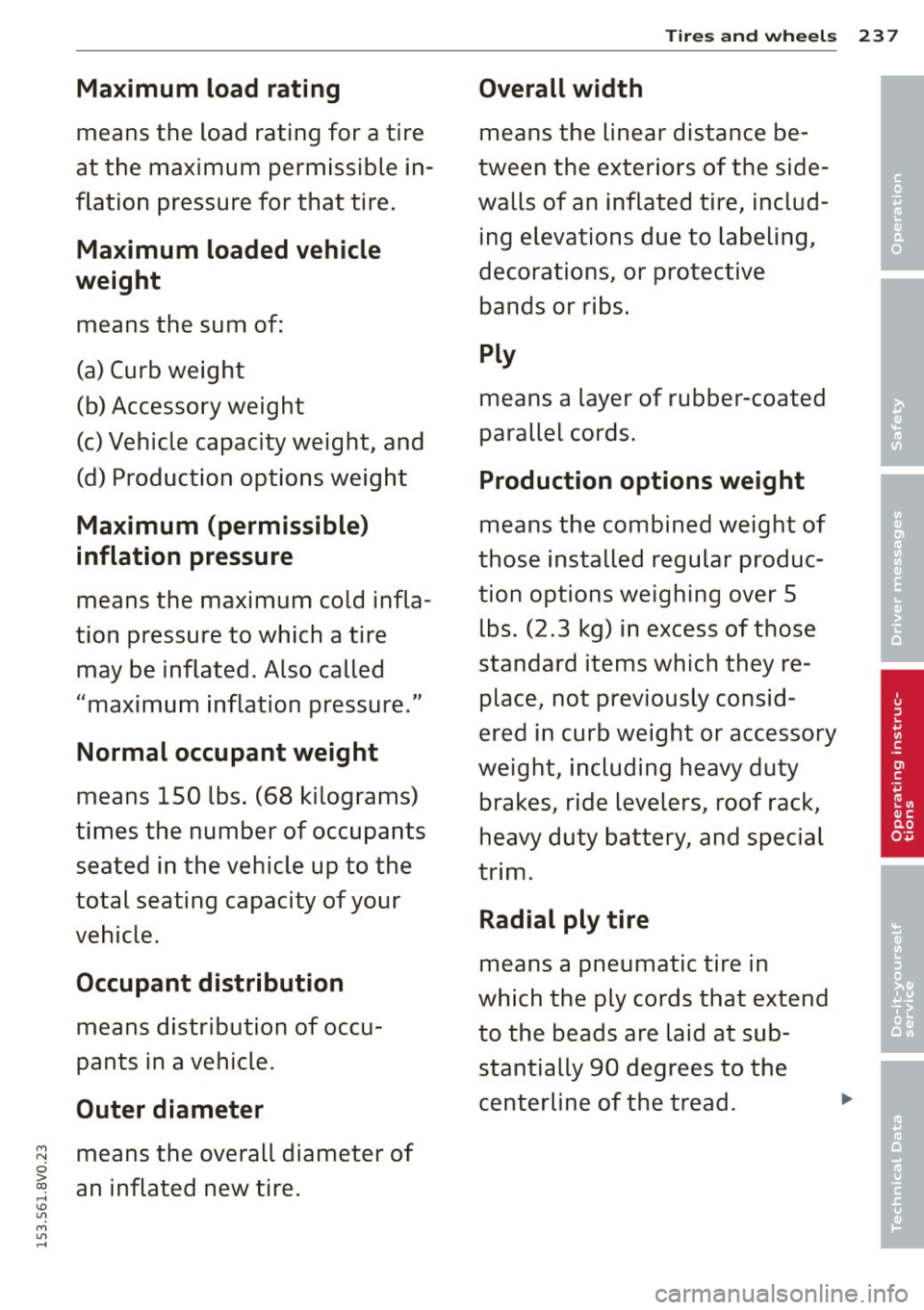
M N
0 > co ,...., \!) 1.1'1
M 1.1'1 ,....,
Maximum load rating
means the load rating for a tire
at the maximum permissible in
flation pressure for that tire.
Maximum loaded vehicle
weight
means the sum of:
(a) Curb weight
(b) Accessory weight
(c) Vehicle capacity weight, and
(d) Production options weight
Maximum (permissible)
inflation pressure
means the maximum cold infla
tion pressure to which a tire
may be inflated. Also called
"maximum inflation pressure."
Normal occupant weight
means 150 lbs. (68 kilograms)
times the number of occupants seated in the vehicle up to the
total seating capacity of your
vehicle.
Occupant distribution
means distribution of occu pants in a vehicle.
Outer diameter
means the overall diameter of
an inflated new tire.
Tires and wheels 237
Overall width
means the linear distance be
tween the exteriors of the side
walls of an inflated tire, includ ing elevations due to labeling,
decorations, or protective bands or ribs.
Ply
means a layer of rubber-coated
parallel cords.
Production options weight
means the combined weight of
those installed regular produc
tion options weighing over 5 lbs. (2 . 3 kg) in excess of those
standard items which they re place, not previously consid
ered in curb weight or accessory
weight, including heavy duty
brakes, ride levelers, roof rack,
heavy duty battery, and special
trim.
Radial ply tire
means a pneumatic tire in
which the ply cords that extend
to the beads are laid at sub stantially 90 degrees to the
centerline of the tread.
' •
•
' •
Page 302 of 310
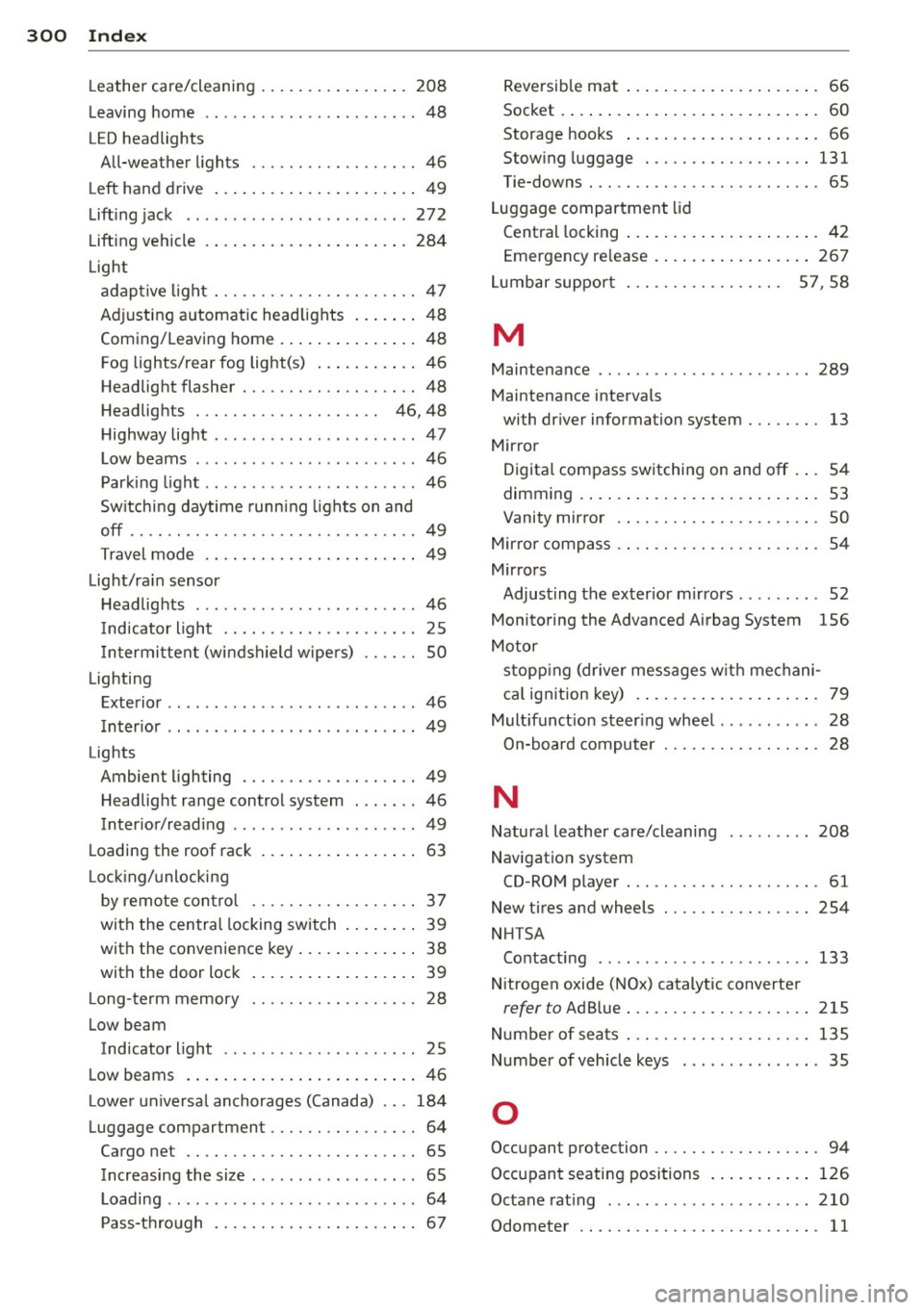
300 Index
Leather care/cleanin g .... ... .. .. .... . 20 8
Le aving home .............. ... .. ... . 48
LED headlights All-weathe r lights ................ .. 46
L eft h and drive .. . ...... ... .. .. .... .. 4 9
Lift ing jack .. .......... ........ ... . 272
Lift ing vehicle . .. ... .... ... .. .. .... . 284
Light ad ap tive lig ht ................ .... .. 47
Ad justing a utomatic head lights ... .. .. 48
Coming/Leaving home ... .. .. .. .... . . 48
Fog lights/rear fog light(s) ... .. .. .. . . 4 6
Headlight flasher ................... 48
H eadlights . . . . . . . . . . . . . . . . . . . . 46, 48
H ighway light ...................... 47
L ow beams .... .... ...... .. .. .. .. .. 46
P ark ing light .............. ... .. .... 46
Sw itching dayt ime runn ing ligh ts on and
off .. .. ................... .. .. .. .. 49
Travel mode . . . . . . . . . . . . . . . . . . . . . . . 4 9
Light/ra in sensor
H eadlights . .............. ... .. .... 46
I nd icator light . . . . . . . . . . . . . . . . . . . . . 25
I n termi ttent (wi ndshield wipe rs) . . . . . . 50
Lighting Exterior ......... ............. ... .. 46
I n ter ior . . . . . . . . . . . . . . . . . . . . . . . . . . . 49
Lights Ambient lighting ................... 49
H eadlig ht range contro l system . ...... 46
Inter ior/read ing ........... ... .. .... 49
Loading the roof rack . . . . . . . . . . . . . . . . . 63
L oc king/ unlocking
by remote con tro l ............ ...... 37
with the cen tral locking switch . ... .. . . 39
with the convenience key . . . . . . . . . . . . . 38
with the door lock ..... ... .. .. .... .. 39
L ong -term memory . . . . . . . . . . . . . . . . . . 28
Low beam Ind icator light . . . . . . . . . . . . . . . . . . . . . 25
Low beams . .... .. ..... ... .. .. .... .. 4 6
L owe r universa l anchorages (Canada) ... 184
Luggage compartment ................ 64
Cargo net ......................... 65
Increasing the size . . . . . . . . . . . . . . . . . . 65
L oading .. .. ... .... ...... ... ... .. .. 64
P ass-t hrou gh . . . . . . . . . . . . . . . . . . . . . . 67 R
eversib le mat . . . . . . . . . . . . . . . . . . . . . 66
Socket . ... .... .. .. ... ..... ... .. .. . 60
Storage hooks . . . . . . . . . . . . . . . . . . . . . 66
Stow ing luggage .............. .... 131
Tie-downs . . . . . . . . . . . . . . . . . . . . . . . . . 65
L uggage compartment lid
Central locking ... ... .. ..... .... . .. . 42
Emergency release . .. .. ..... ... .. .. 267
L umbar suppo rt . . . . . . . . . . . . . . . . . 5 7, 58
M
Maintenance ...... ................ . 289
Maintenance intervals
with driver information system . . . . . . . . 13
Mir ror
Digital compass sw itching on and off . . . 54
dimming . ..... .. .. ... ..... ... .. .. . 53
Vanity mirror . . . . . . . . . . . . . . . . . . . . . . 50
Mir ro r compass . . . . . . . . . . . . . . . . . . . . . . 54
Mirro rs
Adjusting the exterior m irrors . . . . . . . . . 52
Monitoring the Advanced Airbag System 156
Motor stopp ing (dr iver messages w ith mechani-
ca l ign ition key) .. .. ... ..... ... .. .. . 79
Mult ifunct ion steer ing wheel ......... .. 28
On-board computer ............ .... . 28
N
Natural leather care/cleaning ......... 208
Navigation system CD-ROM p layer . . . . . . . . . . . . . . . . . . . . . 61
New ti res and wheels ............ .... 254
NHTSA Contacting .. .. ....... ........... . 133
N itrogen oxide (NOx) catalytic converter
refer to Ad Blue ................ .... 215
N umber of sea ts . .. ............. .... 135
Number of vehicle keys ............... 35
0
Occupant protection .................. 94
Occupant seating positions .. ... .. .. .. 126
Octane rat ing . .. ....... ........... . 210
Odometer . . . . . . . . . . . . . . . . . . . . . . . . . . 11
Page 304 of 310
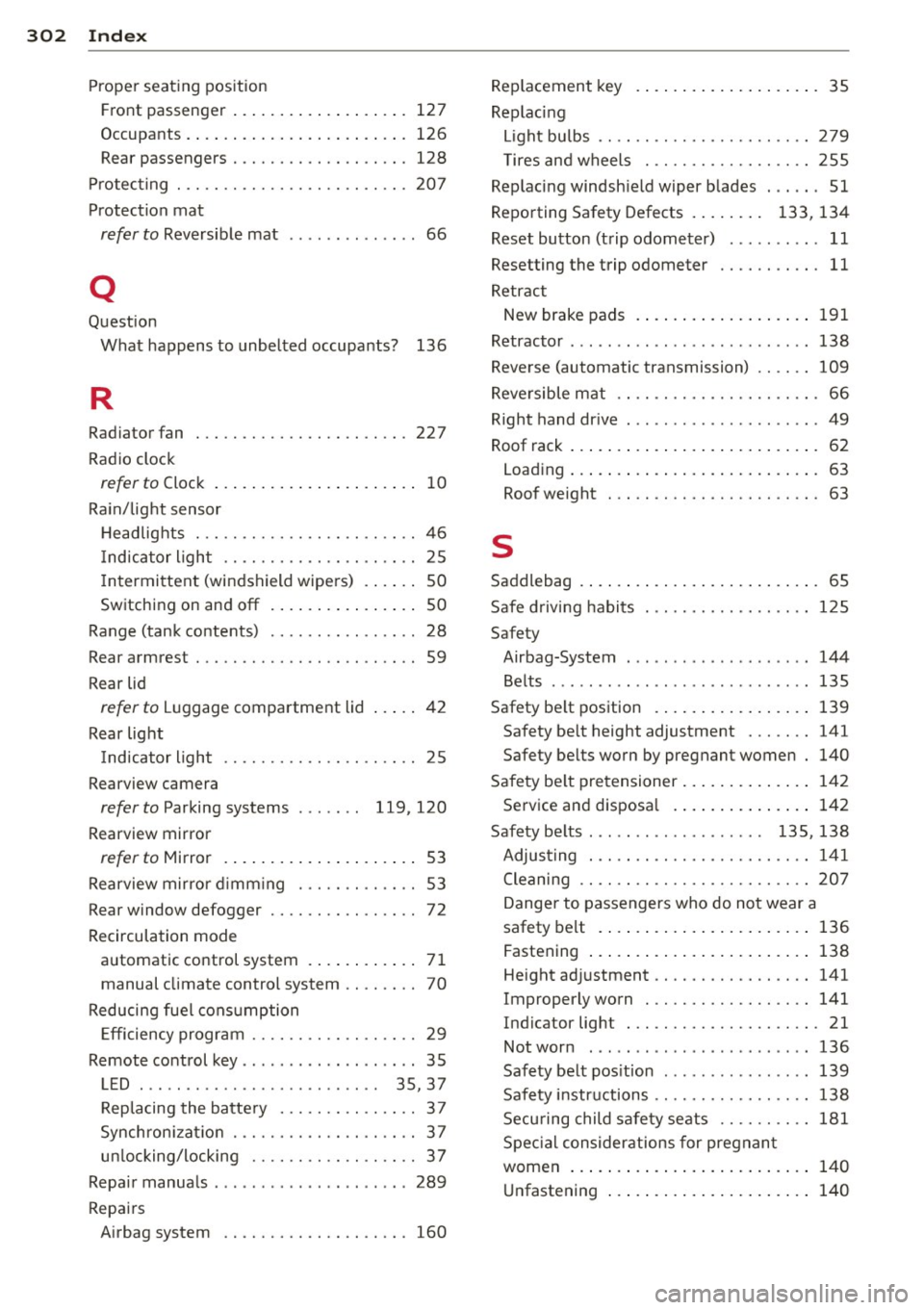
302 Index
Proper seating position Front passenger ....... ... .. .. .... . 127
Occupants . .... ... ...... ... .. .... . 126
Rea r passengers . . . . . . . . . . . . . . . . . . . 128
P rotecting . .... ........... .. .. .. .. . 20 7
Protection mat
refer to Reversible mat . . . . . . . . . . . . . . 66
Q
Question
What happens to unbelted occupants? 136
R
Radiator fan 227
Radio clock
refer to Clock .. .. ..... ... .. .. .... .. 10
Ra in/ lig ht sensor
H ead lig hts ... ........... .. .. .. .. .. 46
I nd icator light . . . . . . . . . . . . . . . . . . . . . 25
I n termittent (windshield wipe rs) . . . . . . 50
Switching on and
off .. .. .. .. .... .. . . 50
Range (tank co ntents) ...... .. .. .... .. 28
Rea r armrest . . . . . . . . . . . . . . . . . . . . . . . . 59
Rear lid
refer to L u ggage compartment lid .... . 42
R ear light
I nd icator ligh t . . . . . . . . . . . . . . . . . . . . . 25
Rearview camera
refer to Parking systems 119 ,120
Rearview mirror
refer to Mirror . . . . . . . . . . . . . . . . . . . . . 53
Rearview mir ror d imm ing ... .... .... .. 53
Rear window defogger . . . . . . . . . . . . . . . . 72
Recirculation mode automatic control system . ... .. .. .. . . 71
manual c limate control system . . . . . . . . 70
Reducing fue l cons umption
E fficiency program . . . . . . . . . . . . . . . . . . 29
Remote control key ............. .. ... . 35
L ED . . . . . . . . . . . . . . . . . . . . . . . . . . 35, 37
Rep lacing the batte ry ..... .. .. .. .. . . 37
Synch ron izati on .......... .. .. .... .. 37
un locking/locking ...... .. .. .. .. .. . . 37
Repair manua ls ............. ... .. .. . 289
Repairs Airbag system ........... .. .. .... . 160 R
ep lacement key . .... .. ..... .... . .. . 35
Replac ing
L ight bu lbs .... .. ............. .... 279
T ires and wheels . ............. .. .. 255
Rep lacing windsh ield wiper b lades . .. .. . 51
Reporting Safety Defects . . . . . . . . 133, 134
Reset button (trip odometer) . . . . . . . . . . 11
Resetting the trip odometer ...... .... . 11
Retr act
New brake pads . ... ... ..... ... .. .. 191
Retractor ...... ... .. .............. . 138
Reverse (automatic transmission) .. .... 109
Reve rsible m at . . . . . . . . . . . . . . . . . . . . . . 66
Right hand dr ive . .. ................ .. 49
Roof rack . . . . . . . . . . . . . . . . . . . . . . . . . . . 62
Load ing ... .... .. .. ... .. . .... ... .. . 63
Roof weight ... .. ... .......... .. .. . 63
s
Saddlebag . . . . . . . . . . . . . . . . . . . . . . . . . . 65
Safe drivi ng habi ts ... ........... .. .. 125
Safety Airbag-System ... ... .. .. ... ..... .. 144
Belts . ........ .. .. .............. . 135
Safety be lt pos ition . .... ..... ... .. .. 139
Safety be lt height adjustment . . . . . . . 141
Safety be lts worn by pregnant women . 140
Safety be lt pre tensioner . . . . . . . . . . . . . . 142
Service and disposal . . . . . . . . . . . . . . . 142
Safety be lts . . . . . . . . . . . . . . . . . . . 13S, 138
Adjusting . .... .. ............. .... 141
Cleaning .. .... .. ............. .... 20 7
Danger to passengers who do not wear a
safety belt . ..... .. ... ..... ... .. .. 136
Fastening . . . . . . . . . . . . . . . . . . . . . . . . 138
Height adj ustment ............. .. .. 141
Improperly worn . ... .......... .. .. 141
Indicator light . ... ................ . 21
Not worn ..... .. .......... ...... . 136
Safety be lt pos it ion .... .. ... ..... .. 139
Safety instr uctions ............. .. .. 138
Secu ring child safety seats .... .. .... 181
Spec ia l considerations for pregnan t
women ... .... .. ... .. ..... ... .. .. 140
Unfastening ..... .. ... ..... ... .. .. 140